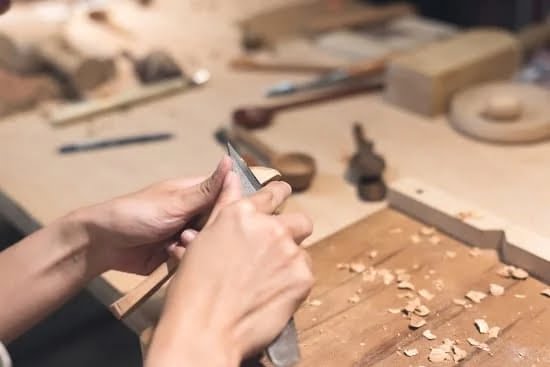What are woodworking hand tools? Woodworking hand tools are manual tools used by woodworkers for shaping, carving, cutting, and finishing wood. These tools have been essential to the craft of woodworking for centuries, and they continue to be valuable in both traditional and modern woodworking practices.
Woodworking hand tools come in a wide variety of forms, each serving a specific purpose in the woodworking process. From measuring and marking to cutting and smoothing, these tools are indispensable for creating handmade furniture, cabinets, sculptures, and other wooden items.
In this article, we will explore the world of woodworking hand tools, starting with an introduction to their importance and relevance. We will also cover essential hand tools for beginners, advanced options for experienced woodworkers, safety tips when using these tools, proper maintenance and care techniques, differences between power tools and hand tools in woodworking, common mistakes to avoid when using them, and a list of must-have hand tools for every woodworking shop.
Whether you’re new to woodworking or a seasoned professional, understanding the role of hand tools is crucial for achieving quality results in your projects.
Essential Woodworking Hand Tools for Beginners
Woodworking is a timeless craft that involves creating and shaping wood with the use of various tools. For beginners, getting started with woodworking hand tools can be overwhelming due to the wide array of options available. However, there are certain essential woodworking hand tools that every beginner should have in their toolbox to kickstart their woodworking journey.
Measuring and Marking Tools
Accurate measurements and markings are crucial in woodworking projects. Therefore, every beginner woodworker should invest in essential measuring and marking tools such as a tape measure, combination square, marking gauge, and pencil. These tools will help ensure precision and accuracy in all woodworking tasks.
Cutting Tools
Cutting is a fundamental aspect of woodworking, and having the right cutting tools is essential for any beginner. A set of high-quality chisels, handsaws, coping saws, and block planes are must-have cutting tools for beginners. These tools will allow beginners to make accurate cuts and shape wood effectively.
Joinery Tools
Joinery is the art of connecting wooden elements together to create strong and durable structures. Basic joinery tools such as a hammer, mallet, nail set, screwdrivers, and clamps are essential for beginners. These tools will enable beginners to assemble their woodworking projects with ease while ensuring sturdy joints.
Having these essential woodworking hand tools for beginners will not only set them up for success but also provide them with the necessary foundation to develop their skills and tackle more advanced woodworking projects in the future.
Advanced Woodworking Hand Tools for Experienced Woodworkers
As experienced woodworkers progress in their craft, they often find themselves seeking more advanced woodworking hand tools to aid them in creating intricate and detailed projects. These advanced tools allow for greater precision, efficiency, and versatility, elevating the quality of their work. Here are some essential advanced woodworking hand tools that every experienced woodworker should consider adding to their collection.
Block Plane
A block plane is a versatile tool that allows experienced woodworkers to smooth rough surfaces, chamfer edges, and shape small pieces of wood with ease. Its compact size and adjustable blade make it perfect for fine-tuning joints and fittings, making it an indispensable tool in any experienced woodworker’s arsenal.
Dovetail Saw
For woodworking projects that require precise and clean cuts for dovetail joints, a dovetail saw is a must-have. This specialized hand saw features a thin blade with a rigid back, allowing for intricate cutting patterns without sacrificing accuracy. Whether working on drawers, cabinets, or other joinery projects, the dovetail saw is an essential tool for experienced woodworkers.
Spokeshave
The spokeshave is a hand tool used for shaping curved wooden pieces such as chair legs, wheel spokes, or rounded table edges. It consists of a steel blade set at an angle in a wooden body with handles on either side for control. With its ability to create smooth and consistent curves, the spokeshave is essential for those who specialize in crafting furniture or other curved woodworking projects.
These advanced woodworking hand tools represent just a few of the many options available to experienced woodworkers looking to expand their capabilities and improve the quality of their work. By investing in these high-quality tools and mastering their use, seasoned woodworkers can tackle more complex projects with confidence and precision.
Safety Tips When Using Woodworking Hand Tools
Woodworking hand tools are essential for any woodworking project, from simple DIY tasks to more complex carpentry and joinery work. These tools come in a variety of shapes and sizes, each serving a different purpose in the woodworking process. However, working with these tools can pose potential hazards if not used properly. In this section, we will discuss some important safety tips to keep in mind when using woodworking hand tools.
First and foremost, it is crucial to always wear appropriate personal protective equipment (PPE) when working with woodworking hand tools. This includes safety goggles to protect your eyes from flying wood chips or sawdust, as well as hearing protection if you are working with loud power tools or hand tools such as chisels and hammers. Additionally, wearing close-toed shoes can prevent injuries from falling tools or sharp objects on the floor.
Another important safety tip is to always use the right tool for the job. Using a tool for a task it wasn’t designed for can lead to accidents or damage to the tool itself. Inspect your hand tools before each use to ensure they are in good condition and replace any damaged or worn-out tools immediately.
Additionally, it’s essential to maintain proper posture and stance when using woodworking hand tools. This means keeping your workspace clean and clutter-free to avoid tripping hazards, as well as positioning yourself in a way that allows for proper leverage and control over the tool. Lastly, always concentrate on the task at hand and avoid distractions when using hand tools to minimize the risk of accidents.
| Safety Tips | Description |
|---|---|
| Wear PPE | Always wear safety goggles, hearing protection, and close-toed shoes. |
| Use the right tool | Inspect your hand tools before each use and make sure you are using them for their intended purpose. |
| Maintain proper posture | Clean your workspace and position yourself for optimal control of the tool. |
Proper Maintenance and Care of Woodworking Hand Tools
Taking care of your woodworking hand tools is essential to ensuring that they remain in good working condition for years to come. Regular maintenance not only prolongs the life of your tools but also ensures that they perform at their best. So, what are woodworking hand tools and how can you maintain them properly?
One important aspect of maintaining woodworking hand tools is keeping them clean and free from rust. After each use, it’s important to wipe down your tools with a clean cloth to remove any sawdust or debris. For tools with metal parts, it’s crucial to keep them dry to prevent rust from forming. You can also apply a thin layer of oil or lubricant to protect the metal components from corrosion.
Sharpening your woodworking hand tools is another key part of maintenance. Chisels, planes, and saws all require regular sharpening to ensure that they cut smoothly and accurately. Investing in a good quality sharpening stone or file will allow you to keep your tools sharp and in top condition.
Proper storage is also essential for the maintenance of woodworking hand tools. Storing your tools in a dry environment away from moisture will help prevent rust and corrosion. Additionally, using protective cases or covers for your tools can also help reduce wear and tear.
| Maintenance Tip | Description |
|---|---|
| Keep Tools Dry | Prevent rust by keeping metal parts dry after use |
| Regular Sharpening | Tools such as chisels and planes require regular sharpening for optimal performance |
| Proper Storage | Store tools in a dry environment away from moisture to prevent rust and corrosion |
Differences Between Power Tools and Hand Tools in Woodworking
Woodworking hand tools and power tools both play an essential role in woodworking projects. Each type of tool has its own advantages and disadvantages, and understanding the differences between the two can help woodworkers make informed decisions about which tools to use for their projects.
Hand Tools:
- Chisels
- Hand saws
- Clamps
- Hammers
- Screwdrivers
Hand tools are operated by manual labor and do not require electricity or batteries to function. They are often favored for their precision, control, and ability to create intricate details in woodworking projects. These tools also tend to be quieter and produce less dust than power tools, making them a popular choice for indoor or small-scale woodworking.
Power Tools:
- Power drills
- Circular saws
- Router
- Jigsaw
Sanders (orbital, belt, etc.)
On the other hand, power tools are driven by electricity or battery power, providing additional strength and speed to complete tasks efficiently. They are often used for heavy-duty or large-scale woodworking projects where precision may not be as critical. Power tools can also help reduce physical strain on the user when handling bulkier materials.
Overall, both types of woodworking tools have their own unique advantages and are often used together in woodworking projects to achieve the best results. Understanding when to use each type of tool is crucial for any woodworker looking to hone their craft.
Common Mistakes to Avoid When Using Woodworking Hand Tools
When it comes to woodworking hand tools, it’s important to use them with caution and precision. Avoiding common mistakes can ensure that your projects are completed safely and accurately. Here are some common mistakes to avoid when using woodworking hand tools:
- Not wearing safety gear: One of the most common mistakes when using woodworking hand tools is not wearing the appropriate safety gear. This includes goggles to protect your eyes from flying wood chips and sawdust, as well as gloves to protect your hands from sharp tools.
- Improper tool usage: Using a woodworking hand tool for a task it wasn’t designed for can lead to accidents and damaged workpieces. It’s important to familiarize yourself with the proper usage of each tool and not force them into tasks they are not meant for.
- Not maintaining sharpness: Blunt woodworking hand tools can be dangerous and lead to poor results. It’s important to regularly sharpen and maintain the sharpness of your tools to ensure they work effectively.
By avoiding these common mistakes, you can ensure that your woodworking projects are safe, accurate, and enjoyable. Remember to always prioritize safety and take the time to properly maintain and use your woodworking hand tools.
Remember that while power tools may offer efficiency in certain tasks, there is a level of control and finesse that only traditional hand tools can provide when it comes to woodworking. As such, it’s crucial to understand how each type of tool works before embarking on any woodwork project.
Overall, by being mindful of these common mistakes and taking the time to properly educate oneself about how best these hand-held devices function within a variety of projects in a wood shop will ultimately lead you on the path toward becoming an expert craftsman in no time at all.
Must-Have Woodworking Hand Tools for Every Woodworking Shop
In conclusion, woodworking hand tools are essential for any woodworking shop, whether you are a beginner or an experienced woodworker. The right set of hand tools can make a significant difference in the quality and precision of your work. From basic tools like saws, chisels, and planes to more advanced tools like spokeshaves and scrapers, having the right collection of hand tools is crucial for any woodworking project.
Proper maintenance and care of woodworking hand tools are also important to ensure their longevity and effectiveness. Keeping your tools sharp, clean, and properly stored will not only extend their lifespan but also ensure that they perform at their best when you need them. Safety should always be a top priority when working with woodworking hand tools, so it’s essential to follow safety guidelines and use protective gear to prevent accidents.
While power tools may offer efficiency and speed, there is a unique satisfaction that comes from using traditional hand tools in woodworking. Knowing how to use both types of tools effectively can elevate your craftsmanship to new levels.
By avoiding common mistakes and investing in the must-have woodworking hand tools for your shop, you can enhance your skills and create beautiful wooden masterpieces. So whether you’re just starting out or have years of experience, having a well-rounded collection of woodworking hand tools is a must for every woodworker.

Hi everyone! I’m a woodworker and blogger, and this is my woodworking blog. In my blog, I share tips and tricks for woodworkers of all skill levels, as well as project ideas that you can try yourself.





